OUR
DECISION
CRITERIA


HOW DO WE DECIDE WHAT GOES INTO OUR PRODUCTS?
Many factors such as effect, tolerability and origin play a major role for us when selecting our ingredients. We often have to weigh up which aspects we give more weight to. It's not that easy! We have outlined exactly how we select our raw materials for you in our decision-making process, and you can find an explanation of the individual steps below the graphic.

1. does the raw material correspond to our company philosophy and fulfill the following criteria?
- Vegan & Animal Friendly
- Silicone-free & mineral oil-free
- As natural as possible, synthetic only if indispensable due to mode of action
- Highest possible biodegradability
- PEG-free(polyethyleneglycol-free)
- Free from water-soluble synthetic polymers & microplastics
- Free from nanoparticles
- Free from drying alcohols
- Free from aggressive surfactants
- Free from parabens and irritating preservatives
- Free from synthetic fragrances
- Free from unnecessary fillers and additives
If one of these criteria cannot be met, the raw material is not used.
2. is the raw material from controlled organic cultivation?
Raw materials in organic quality are preferred. Exception: If the raw material cannot be procured due to long delivery times or current availability, a conventional quality can be used temporarily. For example, if a product launch is at risk or the product could be sold out too quickly.
3. how regional is the raw material?
If the raw material is available regionally (at least within Europe), it is preferred. The more regional a raw material is, the better. Exception: If the raw material cannot be procured due to long delivery times or current availability, an alternative quality can be used temporarily. For example, if a product launch is at risk or the product could sell out too quickly.
4. is the raw material palm oil-free?
Palm oil-free raw materials are preferred, with the exception of increased use of coconut, soy, sunflower or rapeseed oil. The use of coconut, soybean, sunflower and rapeseed oil would result in massively higher land requirements.
5. examination of ecological and social criteria
If raw materials containing palm oil are used, they must meet strict ecological and social criteria and be certified accordingly.
6. raw material valuation according to CSR
In this step, the raw material is evaluated according to CSR aspects. This includes social, ecological and economic responsibility in relation to the environment and society.
- Environmentally friendly and resource-conserving handling: What methods are used for cultivation and harvesting? If it is an upcycled raw material or if the raw material is used in its entirety and not wasted, this is to be preferred.
- Is attention paid to the protection and preservation of species diversity and biodiversity during cultivation and harvesting (CITES)?
- Is the raw material easily biodegradable? Preferable if possible.
- Desirable: Does the raw material supplier have specific, internationally recognized certificates, e.g. Regenerative Organic Certification, Fairtrade seal for cosmetics, (Fair) For Life, CO2 certificates, etc.?
- Desirable: Is the raw material processed in compliance with the Green Chemistry Standard?
- If possible: social standards: What are the local working conditions like? Are workers paid fairly? Is child and forced labor excluded?
- If possible: Are local social or ecological projects supported in order to preserve nature or improve the lives of people and animals?
- Is the raw material available in sufficient quantities so that it can be ordered from a supplier?
7. commodity valuation by performance
Evaluation of the raw material according to its performance in the application test. Criteria such as
- How well tolerated is the raw material on the skin?
- What does the raw material smell like?
- How pleasant is the feeling on the skin?
- Can a stable and microbiologically safe recipe be guaranteed with the raw material, etc.?
Once all criteria (steps 1-7) have been evaluated, the new ingredient is finalized.











